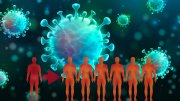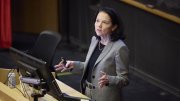One of the basic indicators for determining the possible course of the coronavirus pandemic is how many other people an infected individual will infect. In epidemiological science, this factor is called the basic reproduction number, or R nought (R0). An R0 of 1 means that, absent interventions in a population without immunity, each infected individual will infect another. Alarmingly, during the past several weeks, epidemiologists have been discussing the possibility that the basic reproduction number of SARS-CoV-2 (the virus that causes COVID-19), originally thought to be in the 2 to 3 range, may be closer to 5 or 6.
Generally, the higher the R0 of any disease, the more difficult it becomes to control with measures such as handwashing, mask-wearing, social distancing, quarantines, and contact-tracing of those exposed to infected individuals. Such preventive measures aim to lower the reproduction number below 1, causing the disease to die out.
One indication that the basic reproduction number is “likely quite a bit higher than 2 or 3,” said assistant professor of epidemiology Michael Mina during a recent conference call with reporters, “is the difficulty that some places are having getting their cases down. These tend to be metropolitan areas” where multiple contacts are inevitable, or “places that aren’t social distancing as much.” The early estimates of R0, he explained, were based on reports that doubling times of the epidemic were on the order of 5 to 6 days. But he believes those approximations were driven primarily by “a complicated relationship between the growth of the epidemic and the growth of testing facilities in different countries. If we look at the actual doubling rates in many places, including the United States death rates, we actually see doubling times that are in the 2- to 3-day period, which suggests an R nought closer to 5 to 6.”
A scientific study supporting this suspicion—which would assign SARS-CoV-2 a reproduction number comparable to smallpox and just slightly below that of the common cold—is a paper from Los Alamos National Laboratory that will appear in the July issue of Emerging Infectious Diseases, a journal published by the U.S. Centers for Disease Control and Prevention. The paper is the kind of hard scientific work that is prompting concerns about the virus’s ability to spread even with partial shutdowns. Senior author Ruian Ke and colleagues at Los Alamos used data from Wuhan, China, to derive a calculation of the SARS-CoV-2 reproduction number, concluding that the R0 of SARS-CoV-2 is likely to be about 5.7, with a 95 percent probability that it lies in a range between 3.8 and 8.9.
Getting to Herd Immunity
If true, this has several important implications, beginning with the concept of herd immunity. Herd immunity occurs when a sufficiently large percentage of a population becomes immune to a disease, either through infection or vaccination, with the result that transmission no longer occurs readily, thus protecting even those who are not immune. In the case of SARS-CoV-2, reports suggesting that herd immunity will be achieved when 55 percent of the population is immune assume that the R0 of the virus is 2.2. If the R0 is 5.7 instead, then 82 percent of the population must acquire immunity—because the higher the reproductive number, the larger the immune population must be to halt the spread of the disease. An R0 of 5.7 rather than 2.2 would require billions more doses of vaccine globally—or, if herd immunity is achieved only through infection, millions of excess deaths worldwide.
Another implication of a higher reproduction number is that seasonality—which, if applicable to SARS-CoV-2, is estimated (based on studies of other coronaviruses) to reduce transmission by about 20 percent during the summer—will not lower the R0 to a range anywhere near 1.
Same Virus, Different Settings
How likely is the 5.7 estimate to be correct? Epidemiologist Marc Lipsitch, a professor at the Harvard T.H. Chan School of Public Health and director of its Center for Communicable Disease Dynamics, says, “There is a view that [the R0] is that high. It stills seems to be a minority view, but I think it is a credible one.” Lipsitch has heard Ruian Ke speak about the Los Alamos findings and later work. He finds it “plausible,” but has not yet decided “how strongly to weight [the] possibility” that the number is as high as 5 or 6.
Why the uncertainty? Calculating the basic reproduction number for SARS-CoV-2 has been notoriously difficult because the number of infected individuals, including those who are asymptomatic, is unknown. That makes calculating the probability that the virus will be transmitted from one person to another—a basic ingredient in the formula for calculating R0—extremely difficult.
Normally, explains associate professor of epidemiology Caroline Buckee, the parameters used to calculate R0 are: the duration of infectiousness; the rate at which infected individuals come in contact with susceptible, uninfected individuals; and the probability that transmission will occur during any given contact.
A key point is that the reproduction number does not depend solely on the virus, Buckee continues. “The contact rate itself,” for example, “is very dependent on the setting”—whether urban or rural, she says. “We know that it is country specific.” When modeling the disease, “we use setting-specific contact rates to the extent that we can and they are…very much dependent on the population in question. If you compare Italy and Germany, for example, we know that the patterns of contact between different age groups are very different because household structures are different.” In Italy, more “children live with elderly grandparents. All of these things affect patterns of how the disease spreads and who will die from it.”
Michael Mina made the same point during his conference call. “In many ways, it doesn’t make a lot of sense to say, ‘This is the R nought for the U.S.,’ because we are such a heterogeneous country,” he explained. “I think it should be viewed in a much more localized fashion. For example, in a rural area, somebody over the course of a week or two of being infectious may not come in contact with a huge number of people… Whereas in New York, somebody at the peak of infection on the subway could on average spread it to very many people. So R nought is really a function of environment and the pathogen itself.”
The implication, he continued, is that “in cities like Boston and New York, in places where there is more potential for transmission, I think we will have to be more careful about how we open up. Continuing to wear masks, continuing to be diligent about washing your hands, about carrying hand sanitizer with you at all times—these things will help, but they will not prevent transmission.” And even though vaccine research and testing are proceeding at a record pace—and a triple-drug antiviral combination tested in COVID-19 patients in Hong Kong has just returned the first positive results for any therapy to treat the disease—he said that governments should in the meantime “put resources into protecting the vulnerable people who end up in the hospital at higher rates,” while at the same time slowly trying “to build herd immunity” in the rest of the population. That, he emphasized, “is one path that we have to become comfortable with, and figure out how to do well.”









